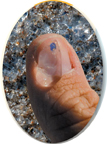A concentration of sense organs and nerve cells in the anterior end of the body is known as
fertilization.
cephalization.
symmetry.
multicellularity.
Which of the following animals shows radial symmetry?
earthworm
fish
insect
sea anemone
Which germ layer produces the nerves and sense organs of animals?
ectoderm
endoderm
mesoderm
periderm
Most chordates that live on land have
two limbs.
four limbs.
six limbs.
eight limbs.
What is an acoelomate?
Describe the major developmental difference that distinguishes protostomes from deuterostomes.
What is a blastula?
List the three germ layers.
Name two body plan characteristics shared by all arthropods and vertebrates.
What is one major advantage of cephalization?
Think Critically
Apply Concepts Why is bilateral symmetry an important development in the evolution of animals?
Sequence Rank the following developments in the order of their appearance during evolution: tissues, deuterostome development, multicellularity, protostome development.
Form a Hypothesis Animals with radial symmetry, such as sea anemones, lack cephalization, while animals with bilateral symmetry have it. State a hypothesis that would explain this observation.
Infer Why is it inaccurate to state that the cladogram of animals shows the improvements in body plans that have occurred over time?

solve the CHAPTER MYSTERY

SLIME DAY AT THE BEACH
Although most people had never seen creatures like these before, biologists had no trouble identifying them. They were salps—descendents of the most ancient members of phylum Chordata. Salps belong to a group of chordates called tunicates. As adults, most tunicates live attached to rocks or the seafloor. Salps are unusual among tunicates: The adults are free-swimming. They pump water in through their mouths and out the other end, feeding and propelling themselves through the water at the same time. Salps are usually found in the surface waters of tropical seas, but they can be carried north by the Gulf Stream and are sometimes washed onto beaches by storms.
Compare and Contrast How are salps different from jellyfish?
Connect to the
 Use the Internet to research salps and other tunicates. Explain why these peculiar-looking animals are classified in the phylum Chordata.
Use the Internet to research salps and other tunicates. Explain why these peculiar-looking animals are classified in the phylum Chordata.

Table of Contents
- Formulas and Equations
- Applying Formulas and Equations
- Mean, Median, and Mode
- Estimation
- Using Measurements in Calculations
- Effects of Measurement Errors
- Accuracy
- Precision
- Comparing Accuracy and Precision
- Significant Figures
- Calculating With Significant Figures
- Scientific Notation
- Calculating With Scientific Notation
- Dimensional Analysis
- Applying Dimensional Analysis




